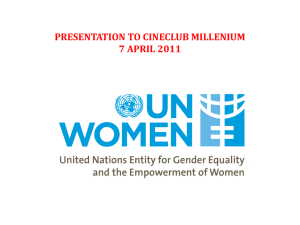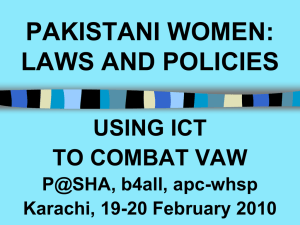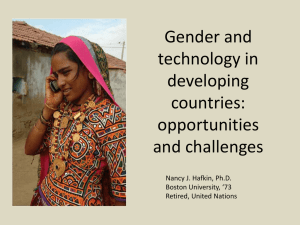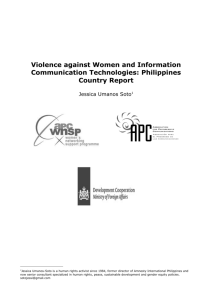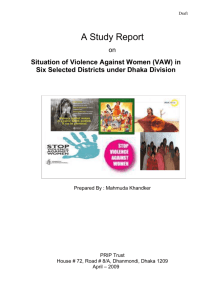Philippines Country Report
advertisement
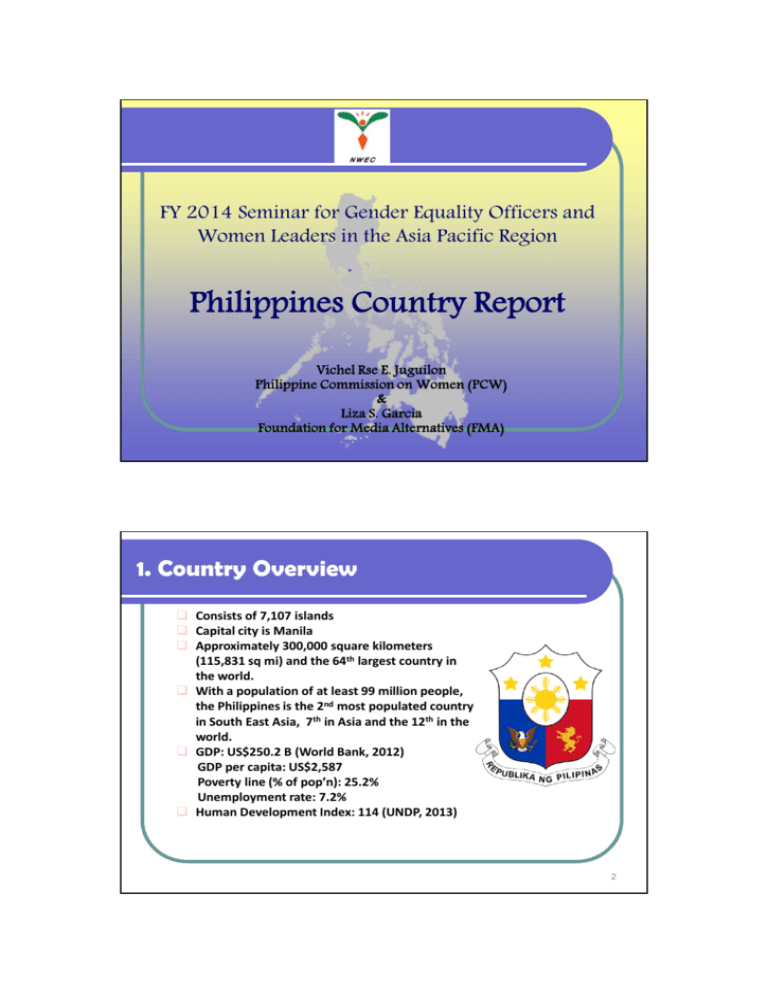
FY 2014 Seminar for Gender Equality Officers and Women Leaders in the Asia Pacific Region Philippines Country Report Vichel Rse E. Juguilon Philippine Commission on Women (PCW) & Liza S. Garcia Foundation for Media Alternatives (FMA) 1. Country Overview Consists of 7,107 islands Capital city is Manila Approximately 300,000 square kilometers (115,831 sq mi) and the 64th largest country in the world. With a population of at least 99 million people, the Philippines is the 2nd most populated country in South East Asia, 7th in Asia and the 12th in the world. GDP: US$250.2 B (World Bank, 2012) GDP per capita: US$2,587 Poverty line (% of pop’n): 25.2% Unemployment rate: 7.2% Human Development Index: 114 (UNDP, 2013) 2 2. Gender Equality Policy “The State recognizes the role of women in nation building and shall ensure the fundamental equality before the law of women and men.” (Art. II, Sec. 14 of the Philippine Constitution) Ratified the United Nations Convention on the Elimination of All Forms of Discrimination against Women (CEDAW) in 1980 Passed into law RA 9710, otherwise known as “The Magna Carta of Women” which is the local translation of CEDAW Philippine Commission on Women is the primary policymaking and coordinating body of the women and gender equality concerns under the Office of the President 3 2. Gender Equality Policy Aside from RA 9710, the Philippines is implementing the following laws: RA 7192- Women in Nation Building and Development Act (1992) RA 7877- Anti-Sexual Harassment Act (1995) RA 8353 and 8505- Anti-Rape Law (1997) and Rape Victim Assistance and Protection Act (1998) RA 9262- Anti-Violence against Women and their Children Act (2004) RA 9775 - Anti-Child Pornography Act (2009) RA 9995 – Anti Photo and Video Voyeurism Act (2012) RA 10354-Responsible Parenthood and Reproductive Health Act (2012) RA 10364- Expanded Anti-Trafficking in Persons Act (2012) RA 10398-National VAW Consciousness Day for the Elimination of VAW (2013) 4 3. Current Situation of Gender Equality in the county (statistics and salient features) In the World Economic Forum’s Global Gender Gap Report 2013, the Philippines ranked 5th out of 136 countries, making it the only Asian country to enter in the top ten since 2006. The Philippines ranks number 8 in the list of “Best Countries for Women to Live In” and is also dubbed as “The Best Place in Asia for Women” 5 3. Current Situation of Gender Equality in the county (statistics and salient features) The Philippines also had 2 women Presidents and women now hold the following positions: Chief Justice of the Supreme Court, Secretary of Justice, Presidential Adviser on the Peace Process, Commissioner of Audit and Commissioner of Internal Revenue 6 3. Current Situation of Gender Equality in the county (statistics and salient features) Indicator Women Men Functional Literacy Rate (%) (10-64 years old) 88.7 84.2 Basic Literacy Rate (%) (10 years and over) 96.1 95.1 Maternal Mortality Ratio (per 100,000 live births) 221 - Life Expectancy at Birth 73.2 67.6 Labor Force Participation Rate (%) 49.8 78.1 Unemployment Rate (%) 5.9 6.8 Proportion of Occupied Elective Positions (%) 20.0 80.0 7 4. Overview of ICTs in the Philippines Internet penetration (2013): 33.6m of population (based on 2012 est. of 92.3m) Penetration based on age 15-24 years old (40%) 25-34 years old (31%) 35-44 years old (16%) 45-54 years old (9%) 8 4. Overview of ICTs in the Philippines Female share of the Internet population: 49% (ComScore, 2013) Women spend an average of 15.6 hours per month on the internet. They are likely to visit sites that relate to family, home and retail FB usage: 92.2% F : 51.9%; M : 48.1 (2010) 9 4. Overview of ICTs ・Media and Gender in the country Indicator Own a cellular phone 81.0 76.0 Use the internet 61.0 57.0 Have an email account 55.0 49.0 56.0 50.0 Have a social networking account 10 4. Overview of ICTs ・Media and Gender in the country Magna Carta of Women Section 19 provides for Non-discriminatory and NonDerogatory Portrayal of Women in Media and Film Gender Equality Guidelines: Guidelines to Protect Women against Discrimination in Media and Film, and Code of Ethics for Media was formulated by the Media and Gender Equality Committee (MGEC) The Women’s EDGE Plan 2013−2016 seeks to address the persistent negative portrayal of women in popular media, especially in film, television, print, and Internet sites. 11 5. Case Analysis: PCW VAW Documentation System (VAW DocS) The VAW Documentation System (VAW DocS) is a secure web-based documentation system that facilitates and integrates the collection and standardization of information from concerned government agencies and other service providers dealing with VAW. VAW statistics which are systematically gathered can be used to guide national policies; e.g. lobbying for anti-VAW legislation Data from the VAW DocS can also be used to gauge the magnitude of the problem which is useful in programming and budgeting as well as improving service provision, i.e. in a locality. When done regularly, it can be used as basis for monitoring the Philippine progress in addressing VAW 12 5. Case Analysis: PCW Gender Mainstreaming Monitoring System (GMMS) The GMMS is the system for managing the GAD profiles, GAD plan and accomplishment report of the agencies and LGUs and for generating related reports. The system is also intended to be a tool for the technical officers of PCW in the provision of technical assistance to agencies and LGUs. 13 5. Case Analysis: PCW Gender Mainstreaming Monitoring System -Profile each agency/Local Government Unit (LGU) which includes among others the organizations vision, mission, description, information available on GAD, including statistics, issuances related to GAD, etc. -Manage the GAD Plan/ AR submission of each agency and its bureaus, regional offices and attached agencies, and LGUs -Monitor agency/ LGU progress in gender mainstreaming ; -Monitor government compliance to the Magna Carta of Women, CEDAW, BPfA, etc; -Generate related reports. 14 5. Case Analysis: FMA Take Back the Tech! campaign Calls on all ICT users, esp. women and girls, to take control of technology and strategically use any ICT platform at hand for ACTIVISM AGAINST GENDER-BASED VIOLENCE 6. Best Practices : How to make media gender-responsive and to enhance inclusion of women and girls in information society GENDER EQUALITY GUIDELINES Launched by the Gender Equality Committee (GEC) for Media, this kit contains three books which are: Code of Ethics for Media (Book 1); Guidelines to Protect Women from Discrimination in Media and Film (Book 2); and Gender Equality Guide (Book 3). 18 6. Best Practices : How to make media gender-responsive and to enhance inclusion of women and girls in information society MCW Mobile Application A contest for college and university students both public and private with support from the Agencia Española de Cooperación Internacional para el Desarrollo (AECID) to develop an Android-based mobile apps based on the Republic Act 9710 or the Magna Carta of Women (MCW). This aims to raise public awareness and popularize the provisions of the MCW and to promote women’s empowerment and gender equality. 19 7. Major Obstacles to overcome gender-bias in the media Stereotyping of women in media may it be in print, photos, television and radio programs, advertisements and films is still pervasive. Low level of awareness and appreciation of media practitioners to the problems related to the negative or inequitable portrayal of women and men The Internet as a means to perpetuate violence against women is of increasing concern. It is utilized to accelerate the sexual exploitation of women and children. 20 7. Major Obstacles to reduce gender gaps in access to ICTs Physical infrastructure, connectivity Lack of access and skills Gender-blind ICT policy, and there is no clear direction on how to address ICT genderrelated issues 21 7. Major Obstacles to reduce gender gaps in access to ICTs Gender and sexuality issues in relation to ICT, specifically internet content regulation, monitoring, surveillance, and privacy which limit the rights to freedom of expression, information and privacy on the net Identifying and defining ICT-related VAW within national legislations, in clarifying issues of jurisdiction and in terms of providing protection for women against these forms violence. 22 8. Conclusion and Policy Recommendations Intensify monitoring of the implementation and compliance of the Gender Equality Guidelines as well as women-related laws especially those that perpetuate VAW through ICTs (R.A. 995, R.A. 9775) Media practitioners need to be capacitated to use gender sensitive language and images in print, photos, television and radio programs, advertisements and films. Women should be represented in all decision-making structures in the ICT sector in order to push for decisions and innovative projects, policies and standards in the ICT sector that will help empower women. 23 8. Conclusion and Policy Recommendations Need to increase the level of understanding and awareness of the opportunities that ICTs could provide for women as this will be one of the ways in bridging the gender digital divide and towards transforming it into digital opportunity. Infrastructure development to address the digital divide, and corollarily the gender divide Education and human resource development to promote ICT awareness 24 8. Conclusion and Policy Recommendations Inclusion of women’s rights perspective for the development of internet and ICT policies; direct participation of women in the development of the policy where the needs of the poor and the marginalized are heard. Ensure women’s access to justice, not just offline but also online, by not merely focusing on protectionism and criminalization but through concrete programs to prevent VAW in cyberspace. 25 Sources and References Factsheet of women and men in the Philippines, National Statistical Authority, March 28, 2014 Philippine Commission on Women website: pcw.gov.ph PCW Filipino Women and Men Factsheet, February 2014 Image sources (Slide 8): http://tenminutes.ph/; http://angbagongfilipino.wordpress.com/page/36/ http://www.interaksyon.com/article/13512/philippines-tops-asia-in-newsweekranking-of-best-places-to-be-a-woman www.pcw.gov.ph http://en.wikipedia.org/wiki/Philippines Women’s Empowerment, Development and Gender Equality Plan 2014-2016, March 014 26 Sources and References ComScore. 2013 SEA Digital Future in Focus comScore. Women on the Web Intel. 2012. Women and the Web www.apc.org https://securityinabox.org/ https://ssd.eff.org/risk/lessons www.itu.int SALAMAT PO! “National Machinery for the Advancement of Women” www.pcw.gov.ph facebook.com/philippine.commission.on.women Twitter: @PCWgovph www.fma.ph facebook.com/takebackthetechPH
